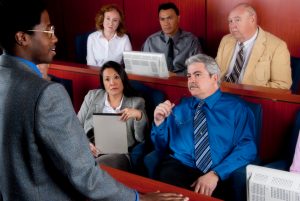Crucial Skills for Crafting Persuasive Trial Presentations: A Comprehensive Guide
Browsing the Complexities of Test Presentations: Tips for Seamless Shipment and Compelling Disagreements
In the world of lawful process, the art of test discussion stands as a crucial factor of success. The complexities intrinsic in test presentations need a delicate equilibrium of ability, skill, and approach.

Recognizing Test Objectives
To efficiently browse a test, it is crucial to have a clear understanding of the objectives that need to be accomplished. Prior to entering the courtroom, legal teams should specify their goals and desired outcomes. These goals serve as assisting concepts throughout the test, forming methods and affecting decision-making procedures.
Recognizing test objectives involves an extensive analysis of the case, legal precedents, and the client's benefits. Trial Presentations. It requires a meticulous examination of the facts, identifying essential problems, and anticipating potential challenges. By setting quantifiable and certain goals, lawyers can customize their discussions and debates to align with the preferred results
Moreover, a clear grip of test goals enables lawful groups to prioritize evidence, witnesses, and lawful disagreements efficiently. It enables the growth of a systematic narrative that resonates with the discretionary, strengthening the total situation discussion.

Organizing Evidence Properly
Having a clear understanding of trial objectives lays the structure for organizing proof effectively in lawful proceedings. By straightening the presentation of proof with the preferred results of the test, legal groups can strengthen their debates and enhance their persuasiveness.
An additional crucial element in organizing proof effectively is developing a logical circulation. Presenting evidence in a consecutive and coherent way can aid build an engaging narrative that supports the lawful arguments being made. Additionally, utilizing aesthetic aids such as graphes, timelines, or charts can even more boost the company of evidence and help in making clear complex connections or series of occasions.
Furthermore, making sure that all proof offered is admissible and appropriate to the case is necessary. Irrelevant or inadmissible evidence can take away from the toughness of the debate and possibly harm the trustworthiness of the offering event. A precise evaluation and selection process ought to be carried out to include only the most impactful and legally sound proof in the test discussion.
Crafting Convincing Narratives
Crafting compelling stories plays a critical role in offering influential disagreements during lawful proceedings. When building a narrative for a test presentation, it is necessary to establish a clear story that highlights essential factors and connects them in a systematic way. By weaving with each other evidence, testament, and lawful arguments right into a influential and cohesive story, legal experts can effectively promote for their customers and moved here enhance the likelihood of a desirable outcome in the court.
Mastering Visual Help
Reliable use of visual help is key to improving the effect and quality of trial presentations. Aesthetic help, when made use of strategically, have the power to streamline intricate details, reinforce bottom lines, and leave a long-term impression on the discretionary. To grasp aesthetic help in test presentations, it is essential to make sure that they are clear, succinct, and pertinent to the arguments being made.
When incorporating visual aids, such as charts, photographs, graphs, or timelines, into a trial presentation, it is necessary to maintain them visually appealing yet expert. The visuals must match the verbal disagreements, supplying an aesthetic representation of the info being reviewed without frustrating the target market with unneeded information.
Additionally, experimenting the visual aids beforehand is necessary to make certain a smooth shipment during the trial. Acquainting oneself with the content, transitions, and timings of each aesthetic help can assist preserve the flow of the discussion and protect against technological glitches that may arise.
Supplying Impactful Closing Debates
An engaging closing argument functions as the end result of a trial presentation, enveloping the core story and convincing the discretionary towards official statement a beneficial choice. To supply an impactful closing disagreement, it is essential to succinctly recap why not look here vital points, highlight the strengths of your instance, and deal with any weak points in a tactical fashion. Begin by detailing the main debates that support your client's setting, emphasizing why the evidence offered throughout the trial sustains your narrative. It is vital to develop a feeling of cohesion and quality, directing the court and jury in the direction of the preferred verdict.
Furthermore, integrating psychological allure can better strengthen your closing argument. Ultimately, a well-crafted closing argument ought to leave a long lasting perception, compelling the judge and jury to rule in your customer's favor.
Conclusion
To conclude, grasping trial presentations involves understanding objectives, organizing evidence, crafting stories, making use of aesthetic help, and providing impactful closing disagreements. By carrying out these approaches properly, legal representatives can offer their situation effortlessly and make compelling arguments in the courtroom. It is crucial to browse the intricacies of trial presentations with precision and ability to accomplish success in legal proceedings.
By lining up the discussion of evidence with the desired end results of the test, legal teams can reinforce their disagreements and improve their persuasiveness (Trial Presentations). To master aesthetic aids in trial discussions, it is vital to make sure that they are clear, concise, and pertinent to the arguments being made
A compelling closing debate serves as the culmination of a test presentation, enveloping the core narrative and persuading the court and jury in the direction of a positive decision. Begin by laying out the primary arguments that sustain your client's placement, stressing why the evidence offered throughout the trial sustains your narrative.In verdict, grasping test presentations includes understanding purposes, organizing proof, crafting narratives, using visual aids, and providing impactful closing disagreements.